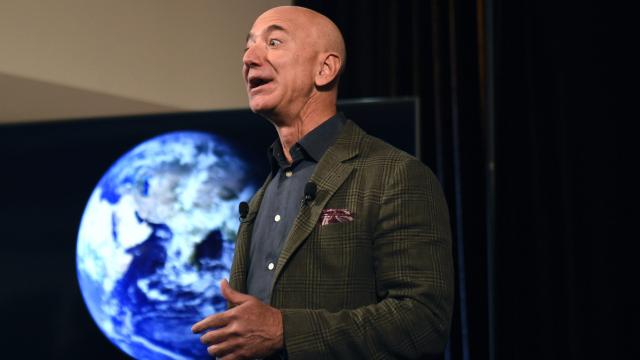On Tuesday, Amazon rolled out a shiny new addition to its flawed climate plan: a $US2 ($3) billion venture investment fund for low- and no-carbon technology. It is instantly one of, if not the, biggest climate venture funds out there. But it also shows a fatal flaw that runs through Amazon’s ” and capital in general’s ” thinking about climate.
At first, blush a $US2 ($3) billion climate fund ” which is separate from CEO Jeff Bezos’s personal philanthropic climate initiative ” sure sounds nice. We can all agree that spending money on climate solutions is generally Good ” so cheers to you, Amazon. The fact that the company has done a good thing can largely be chalked up to employees who have fought the company tooth and nail to be a better corporate citizen. There would almost certainly be no Amazon climate pledge, no $US2 ($3) billion fund, no all-electric vehicle commitment without Amazon Employees for Climate Justice turning the screws on the company. So actually, cheers to AECJ.
There’s a catch to all the cheersing, though, beyond the fact that Amazon has been talking out both sides of its mouth on climate for a while now. Hell, even as it announced this new fund, as the Verge helpfully notes, Amazon’s carbon footprint rose 15 per cent last year. In its announcement, Amazon said the fund “will invest in visionary companies whose products and solutions will facilitate the transition to a low-carbon economy. … The scope of The Climate Pledge Fund is global and will consider investments in companies developing products or services that reduce carbon emissions and help preserve the natural world.”
Basing its investment decisions solely on how much carbon gets cut ignores the fact that not all climate solutions will be equally distributed. Amazon’s commitment to using the venture capitalist model to fund solutions ensures the world will remain unequal (or worse, grow more so). Amazon could borrow a page AECJ’s first open letter to Bezos penned a year ago, asking the company to focus on solutions that reduce harm to the most vulnerable communities first.” It would require a radically different strategy for Amazon, putting human life and equality on par or even above profit. But without it, the company will just perpetuate the same uneven world.
While it remains to be seen what type of climate solutions Amazon will throw its weight behind with the fund, the company has already made it pretty clear it does not grasp that this is not a technocratic problem. The real issue isn’t that we’re waiting for some “visionary” company or “products or services” that will magically solve the climate crisis. We could go about doing it with the technology available to us today!
No, the real issue is that we have a severely constrained political system captured by the billionaire class and fossil fuel industry that refuses to throw the weight of the government. It’s that companies like Amazon are allowed to pollute with impunity and accumulate unfathomable sums of money while doing so.
That concentration of wealth has helped fuel the fabulously carbon-intensive lifestyles of Amazon’s CEO, shareholders, and the otherwise rich, plutocratic, and famous while simultaneously putting poor people more at-risk of losing everything to climate disasters and exposure to toxic pollution. In other words, climate change and inequality are inextricably linked and any efforts to combat one that doesn’t include a focus on the other will only perpetuate a broken system.
The venture capital mentality already focuses on funding companies that maximise profit by trapping people in the gig economy or otherwise fostering inequality. The people most at-risk in a climate change-ravaged world are not the ones who will benefit directly from some start-up’s moonshot climate idea, and, in some cases, they could actually suffer from Amazon’s investments. Natural solutions to climate change like managing forests to suck up carbon dioxide have often been used as an excuse to displace Indigenous people from their land. A border wall with solar panels to generate local electricity is still a symbol of hate and oppression. Innovation alone is not enough. Any investment that ignores this reality will end up being wildly dangerous and misguided. To do this project right would require Amazon to focus not just on how much carbon a project could cut, but what its actual impact on the most vulnerable would be.
Ploughing $US2 ($3) billion into climate solutions and reaping the rewards of an ownership stake in companies pushing for tech fixes to climate will also allow Bezos ” who has seen his fortune balloon by tens of billions of dollars since the pandemic began ” and his company to cash in the climate crisis and simultaneously worsen the inequality crisis. It’s the exact type of “fake change” Anand Giridharadas has warned about as a way to keep plutocrats on top.
But then the Amazon model has always put profits over people, grinding down workers for a comparative pittance and playing hardball with local politicians while reaping billions in profits. If Amazon wanted to, it could clean up its own carbon emissions. The company could stop giving money to elected officials who deny climate change. It could stop letting oil and gas companies use its cloud computing for fossil fuel exploration. Its board could have backed onto the environmental justice resolution.
All those choices would be much more meaningful than a $US2 ($3) billion venture capital fund. They also require Amazon to do the right thing by people and maybe take a hit to its bottom line (that it could surely afford). Instead, it’s bringing the Amazon model of money and power to climate solutions. If the world follows the Amazon route, it’ll just end up being a place where wind turbines swirl over continued systemic injustice and eroding democracy. I, for one, would rather we not go down that road.
